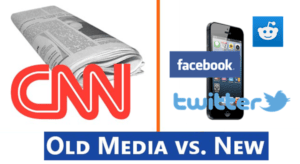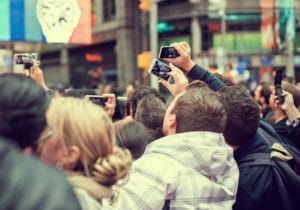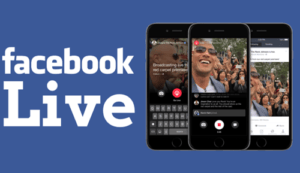Bu-bye CNN
 Bu-bye CNN: a reader asks…
Bu-bye CNN: a reader asks…
I was surprised to see that the biggest news in Washington DC the other evening wasn’t on television. After Speaker Paul Ryan tried to cut off media attention to Democrats doing a Woodstock-era sit-in to advocate for some (any) gun control, mainstream media was cut off. But suddenly amateur video was popping up all over the internet, keeping the video and audio newsworthy event in the public eye. Politics aside, can you tell me what’s happening in technology that makes this possible?
Yes, politics aside, the public, for better or worse, now has alternative methods for information distribution, gathering and display besides network and cable television news programs. One small note of politics (my opinion/rant): the days are long-gone where hard news is given to us by news organizations. Everywhere money, politics and marketing are skewing what we see and hear on venerable news sources. Stories are slanted, the truth is creatively told, and so much context is left out that no one source can be trusted – anywhere. Pretty much every news reporter has been subverted by the powers that generate his/her paycheck.
 But back to the technology. At that event, a couple of plucky Congressmen whipped out their smartphones and started broadcasting the event to the world. Chagrined CNN picked up the feed and re-broadcast it, but most people watched it on Facebook Live or Periscope, two popular ways to get newsworthy events in the public eye. I think the power of broadcast journalism is being degraded, live before our eyes. Particularly with Millenials and younger people who now choose social media as their weapon of choice for news-gathering.
But back to the technology. At that event, a couple of plucky Congressmen whipped out their smartphones and started broadcasting the event to the world. Chagrined CNN picked up the feed and re-broadcast it, but most people watched it on Facebook Live or Periscope, two popular ways to get newsworthy events in the public eye. I think the power of broadcast journalism is being degraded, live before our eyes. Particularly with Millenials and younger people who now choose social media as their weapon of choice for news-gathering.
 With over a billion users on the planet, Facebook is one of the easiest ways for anyone to start broadcasting. It’s as easy as opening Facebook on your smartphone, tapping the “What’s on your mind?” to begin making a status update, and tapping “Live Video” on the Update Status page that comes up. It’s helpful to write something describing the event to others, and of course it helps if you have zillions of friends who will get notified that you’re broadcasting and hopefully re-share your broadcast with their friends (and so on). Pretty much anyone can do this, all you need is a smartphone with a camera and the facebook app and account. While Facebook is rife with silly cat videos and other non-news, it is certainly also being used by citizen-journalists and folks who simply want people to see first-hand what’s happening. The biggest limitation of Facebook Live is that you can’t broadcast for more than 90 minutes at a time. You can control who can see your broadcast through Facebook’s familiar status posting controls, and friends can add their comments to your video stream.
With over a billion users on the planet, Facebook is one of the easiest ways for anyone to start broadcasting. It’s as easy as opening Facebook on your smartphone, tapping the “What’s on your mind?” to begin making a status update, and tapping “Live Video” on the Update Status page that comes up. It’s helpful to write something describing the event to others, and of course it helps if you have zillions of friends who will get notified that you’re broadcasting and hopefully re-share your broadcast with their friends (and so on). Pretty much anyone can do this, all you need is a smartphone with a camera and the facebook app and account. While Facebook is rife with silly cat videos and other non-news, it is certainly also being used by citizen-journalists and folks who simply want people to see first-hand what’s happening. The biggest limitation of Facebook Live is that you can’t broadcast for more than 90 minutes at a time. You can control who can see your broadcast through Facebook’s familiar status posting controls, and friends can add their comments to your video stream.
 The other technology used in that Congressional sit-in is Periscope (owned by Twitter since last year). Periscope has made it really easy to use, just download the app for your iPhone or Android smartphone, login with your Twitter account, give the app permission to use your smartphone’s camera and microphone and you’re ready to start broadcasting. You can choose to tweet first, and your video feed will go to all your Twitter followers. If you don’t do that, folks will have to find you or already be following you on Periscope in order to see your broadcast. By default, all your broadcasts are public, but you can easily limit who can see your broadcasts to just followers. Viewers can comment using the Periscope app including using emojis. There are no set limitations on how long you can broadcast, although if you’re using your own data plan (instead of Wi-Fi) it can get expensive – video streaming either in or out can use up all of your monthly data allowance very quickly.
The other technology used in that Congressional sit-in is Periscope (owned by Twitter since last year). Periscope has made it really easy to use, just download the app for your iPhone or Android smartphone, login with your Twitter account, give the app permission to use your smartphone’s camera and microphone and you’re ready to start broadcasting. You can choose to tweet first, and your video feed will go to all your Twitter followers. If you don’t do that, folks will have to find you or already be following you on Periscope in order to see your broadcast. By default, all your broadcasts are public, but you can easily limit who can see your broadcasts to just followers. Viewers can comment using the Periscope app including using emojis. There are no set limitations on how long you can broadcast, although if you’re using your own data plan (instead of Wi-Fi) it can get expensive – video streaming either in or out can use up all of your monthly data allowance very quickly.
There are plenty of other ways to live-stream events as they happen, but these two seem to be the most ubiquitous. Many other social networking platforms have video sharing built right in, so it all boils down to your intended audience. So for example, if everyone you know uses Snapchat, then you should use that.
This website runs on a patronage model. If you find my answers of value, please consider supporting me by sending any dollar amount via:
or by mailing a check/cash to PosiTek.net LLC 1934 Old Gallows Road, Suite 350, Tysons Corner VA 22182. I am not a non-profit, but your support helps me to continue delivering advice and consumer technology support to the public. Thanks!







